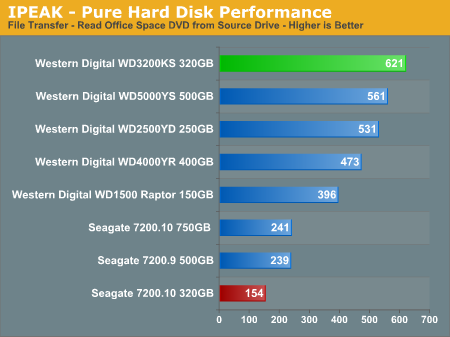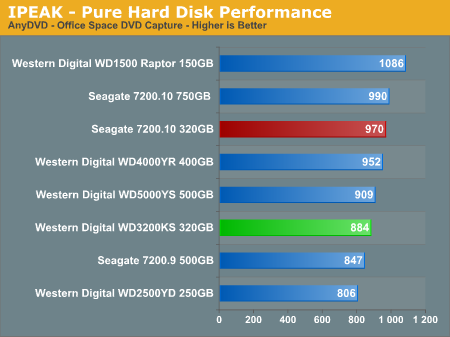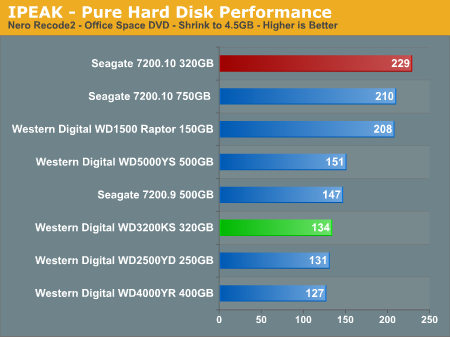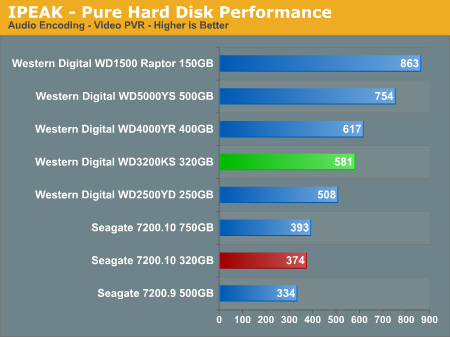Western Digital and Seagate: 320GB Grudge Match
by Gary Key on July 27, 2006 2:00 AM EST- Posted in
- Storage
IPEAK File Transfer Tests
Our IPEAK based File Transfer benchmarks indicate how well a drive performs in a strictly read or write operation with a limited number of files (29) but a large amount of data (7.55GB). The test is designed to ensure continual write or read operations across a large section of the drive and requires constant head and actuator movements along with caching large amounts of data.


The read performance of the WD3200KS is very impressive in these benchmarks while the write performance is average compared to the group. The Seagate 7200.10 320GB read performance is dismal compared to the other drives while its write performance was above average. This is interesting as its read performance in the anti-virus test was excellent. After further examination of the trace files we noticed the read requests in the anti-virus test consisted of mostly small block sizes in continual patterns compared to very large block sizes in irregular patterns in the file transfer test that hampered its performance. We are still looking into this as it seems to be an overall issue with the Seagate drives in general that indicates a poorly tuned firmware or cache design.
IPEAK Video/Audio Tests
The IPEAK based Video/Audio benchmarks are designed around simulating media encoding and HTPC activities. These are basic benchmarks at this time as this section will be expanded greatly with some new tools that we have developed that will be introduced in our 500GB roundup. Our change to a dual core processor will assist us in maintaining a balance between the CPU and Storage systems during the trace file creation and benchmarking processes. These benchmarks are CPU intensive in nature but also require a balanced storage system with the ability to handle read and write requests simultaneously in a very efficient manner.




The AnyDVD benchmark is heavily weighted to write requests with the results showing a common pattern with the WD Raptor finishing first and the Seagate 7200.10 320GB placing about 9% ahead of the WD3200KS. The Seagate 7200.10 750GB posts excellent scores in this area and should since its platter density lends itself well to this process.
The NeroRecode 2 benchmark is weighted to streaming read requests but is balanced by continuous write operations. This benchmark is one of the most demanding ones in our test suite with the disk being active the entire trace file with several 100% utilization peaks. The Seagate 7200.10 320GB posts the best scores here with a victory over the Raptor and finishing ahead of the 750GB drive. The WD3200KS finishes near the bottom but does not offer the same strong read performance we noticed in the file transfer tests where a limited number of like file sizes are utilized.
Our video and audio encoding benchmarks that stream a continuous data feed clearly favor the high and sustainable transfer rates of the Raptor. We recently updated this benchmark so previous results cannot be compared. The Seagate 7200.10 320GB is about 10% quicker than the WD3200KS in the video streaming benchmark and about 8% in the more demanding audio encoding process. These results continue the pattern where sequential requests favor the Seagate drive and random (chaotic) requests favor the WD drive.
Our IPEAK based File Transfer benchmarks indicate how well a drive performs in a strictly read or write operation with a limited number of files (29) but a large amount of data (7.55GB). The test is designed to ensure continual write or read operations across a large section of the drive and requires constant head and actuator movements along with caching large amounts of data.


The read performance of the WD3200KS is very impressive in these benchmarks while the write performance is average compared to the group. The Seagate 7200.10 320GB read performance is dismal compared to the other drives while its write performance was above average. This is interesting as its read performance in the anti-virus test was excellent. After further examination of the trace files we noticed the read requests in the anti-virus test consisted of mostly small block sizes in continual patterns compared to very large block sizes in irregular patterns in the file transfer test that hampered its performance. We are still looking into this as it seems to be an overall issue with the Seagate drives in general that indicates a poorly tuned firmware or cache design.
IPEAK Video/Audio Tests
The IPEAK based Video/Audio benchmarks are designed around simulating media encoding and HTPC activities. These are basic benchmarks at this time as this section will be expanded greatly with some new tools that we have developed that will be introduced in our 500GB roundup. Our change to a dual core processor will assist us in maintaining a balance between the CPU and Storage systems during the trace file creation and benchmarking processes. These benchmarks are CPU intensive in nature but also require a balanced storage system with the ability to handle read and write requests simultaneously in a very efficient manner.




The AnyDVD benchmark is heavily weighted to write requests with the results showing a common pattern with the WD Raptor finishing first and the Seagate 7200.10 320GB placing about 9% ahead of the WD3200KS. The Seagate 7200.10 750GB posts excellent scores in this area and should since its platter density lends itself well to this process.
The NeroRecode 2 benchmark is weighted to streaming read requests but is balanced by continuous write operations. This benchmark is one of the most demanding ones in our test suite with the disk being active the entire trace file with several 100% utilization peaks. The Seagate 7200.10 320GB posts the best scores here with a victory over the Raptor and finishing ahead of the 750GB drive. The WD3200KS finishes near the bottom but does not offer the same strong read performance we noticed in the file transfer tests where a limited number of like file sizes are utilized.
Our video and audio encoding benchmarks that stream a continuous data feed clearly favor the high and sustainable transfer rates of the Raptor. We recently updated this benchmark so previous results cannot be compared. The Seagate 7200.10 320GB is about 10% quicker than the WD3200KS in the video streaming benchmark and about 8% in the more demanding audio encoding process. These results continue the pattern where sequential requests favor the Seagate drive and random (chaotic) requests favor the WD drive.










20 Comments
View All Comments
patentman - Monday, July 31, 2006 - link
To avoid superparamagnetism, engineers have been increasing the coercivity, the field size required to write a bit, of the disc media. These fields are limited by the magnetic materials making up the write head that will soon effectively limit drive sizes utilizing longitudinal recording. Although additional capacities are still achievable, the drive industry will be moving to perpendicular recording technology shortly as longitudinal recording has basically hit the proverbial brick wall after being utilized for nearly 50 years."I wrote a pretty detailed post on the anandtech forums about this a while back. You can check it out http://forums.anandtech.com/messageview.aspx?catid...">here" (I used to post under the nickname "klaviernista"). Considering I examined and issued a lot fo the patents that are the basis of seagate's perpendicular technology, I think I am more than qualified to speak on the matter.
Oh, and for the record, the "soft" magent under layer is never truly "written to" during the reocrind gprocess. The soft magnetic underlayer is made of a material that has magnetic domains which rotate easily in response to an external magentic field. When the write field goes across any given point in the medium, it induces the field in the corresponding point on the soft magentic underlayer to rotate perpendicular to the medium. The article is correct in saying that the result is a substantial increase in write field intensity, but neglects to mention that the fields of the soft magnetic underlayer to not remain oriented perpendicular to the media surface after the write field from the magentic head is removed, whereas the fields in the magentic recording layer do remain oriented perpendicular to the media surface.
The whole point of usuing a soft magnetic underlayer is to allow magnetic materials with very high coercivity to be used as the recoprding layer. Why do you need a very high coercivity recording layer in high density recordng media? See the post I linked to above and read the discussed about "intergranular exchange coupling."
jackylman - Thursday, July 27, 2006 - link
In the pulldown menu, accoustics -> acousticsSonicIce - Thursday, July 27, 2006 - link
Even with an extra platter to lug around, the Western Digital was quieter and cooler!madfly - Thursday, July 27, 2006 - link
if you want to have the seagate hard drive cross shipped where they send you a replacement and you return the defective one back to them they charge $25, considering the hard drive cost $99, that there is a ripoff. I had this happen to me with a 250GB HD that I bought last year, so I'll be spending my money with one of the others unless the deal is ridiculous.Mana211 - Thursday, July 27, 2006 - link
SPCR uses 1 meter (aka 1000mm or 200 times your stated distance) to measure SPL."Each drive is measured for SPL one meter away from the top of the hard drive. Hard drive noise tends to be directional, the loudest position being directly over the top. SPL readings typically drop by 2~3 dBA/1m when measured from the side of the drive. The drive is placed on a soft foam to ensure that no vibration noise is produced during testing."
The there is an entire category of sounds you hear at 5mm that wouldn't be noticable from outside a case.
Take this quote from SPCR: "Consider the distance of Hardware.fr's recording microphone: 5cm from the HDD. This is a serious problem. There's no way the decibel reading can be accurate due to boundary effects. It's the same problem at storagereview.com -- not even relative differences are necessarily correct due to compression effects; the close proximity impacts every measurement similarly, reducing differences."
http://www.silentpcreview.com/article631-page1.htm...">http://www.silentpcreview.com/article631-page1.htm... shows that the new audio recordings (not to be confused with the SPL Dba numbers) will use two recording distances:
* One meter so that "nominal" volume, audibility, and sound character can be judged.
* One foot (or 30 cm if you will) to capture all the details from even the quietest noise sources.
tuteja1986 - Thursday, July 27, 2006 - link
Western digital for me since i want a quiet and cool drive.crydee - Thursday, July 27, 2006 - link
The WD400YR and WD500YS seem very close to performance with the Raptor, but I can't find the WD400YR on pricewatch on newegg also I read about the WD drivers having a high rate of doa?AdamK47 3DS - Thursday, July 27, 2006 - link
The Seagate drive has a performance advantage with the two 160GB platters. Anandtech is still ignoring the advantages of higher platter densities. Why is that? Platter density is one of the features I look at when purchasing a new drive. It's a good indication of performance when compared to another drive of the same total capacity. You have two 320GB drives reviewed with different number of platters and yet there is no mention of this other than the table. It's very odd.evilharp - Thursday, July 27, 2006 - link
Check your "price bot" settings. Currently you list the following deals for a "Western Digital Caviar® SE16"I followed the Business Computing Network link (simply due to the crazy price) and it is for a 20 unit bulk purchase.
Booty - Thursday, July 27, 2006 - link
On the last page it should be listed that the WD has a 3 year warranty for retail and 1 year for OEM - you have them switched.